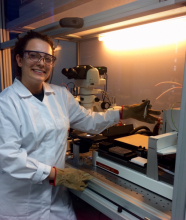
University:
Major:
Site Abroad:
Mentor(s):
Faculty Sponsor(s):
Project Title:
Project Description:
Glaucoma is currently one of the leading causes of irreversible blindness worldwide. It is caused by damage to the ocular nerve due to elevated intraocular pressure. The Human Trabecular Meshwork (HTM) is a porous structure located in the eye that regulates intraocular pressure. It is composed of 3 geometrically different layers with pore dimensions varying from 0.1µm to 25µm. The HTM in glaucomatous patients shows increased stiffness and resistance to aqueous humor outflow. Our goal was to recreate the HTM structure using Melt Electrostatic Writing (MEW), which is a new bioprinting technique that uses a high voltage to deposit well-organized fibers with diameters in nano- to micrometer range. This synthetic scaffold could potentially replace the HTM structure in glaucomatous patients or serve as an in-vitro testing model. Printing of Polycaprolactone (PCL, Mw ~14,000), which is an FDA-approved biodegradable material, was done with the BioScaffolder 3.1 (GeSiM, Germany). We determined the optimal parameters that produced stable microfibers and printed defined patterns. We recreated the structure of the HTM by printing a scaffold composed of 3 layers with different strand diameters (12µm – 25µm) and pore sizes (5µm – 25µm). The structures were imaged using brightfield microscopy and scanning electron microscopy. The mechanical properties of the prints were measured using an indentation test to compare our scaffold with different designs and relate them to known properties of the HTM. Our future goals for this project are to determine HTM cell viability and functionality on the printed scaffolds by staining for HTM cell markers.
